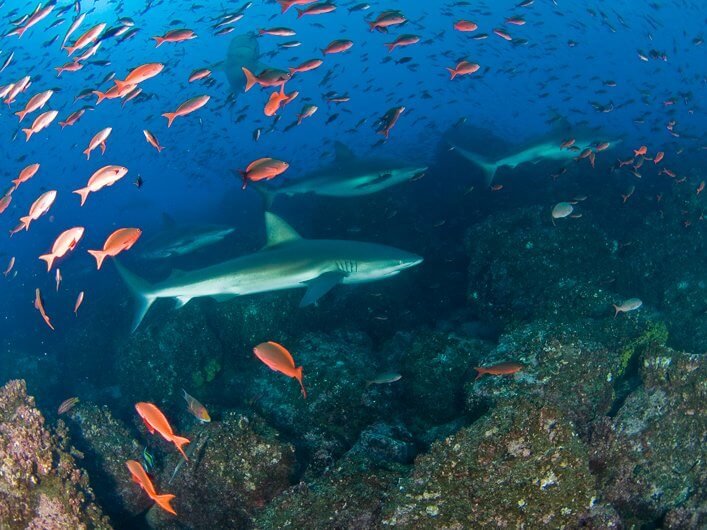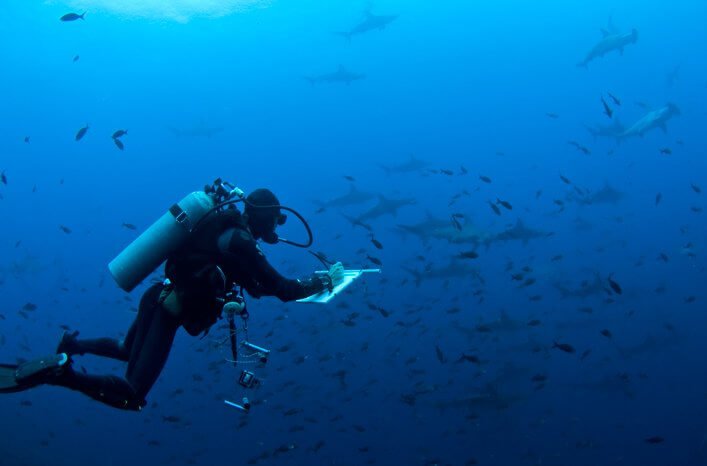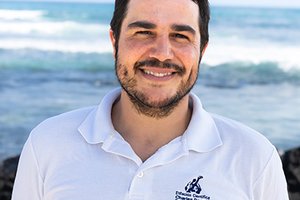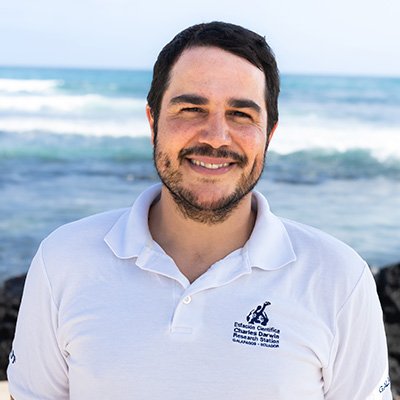
Ecuador Designated Area a Marine Sanctuary Last March: Ensures Protection of Hammerheads, Reef Sharks and Other Top Predators.
In a study published today in the journal PeerJ, scientists from the Charles Darwin Research Station (CDRS) and the National Geographic Society revealed that the northern Galápagos islands of Darwin and Wolf are home to the largest shark biomass reported to date (12.4 tons per hectare).
Worldwide, overfishing has reduced the biomass of most sharks and other large predatory fishes by more than 90 percent — even in remote areas. The findings detailed by CDRS and National Geographic Society researchers in PeerJ are significant because the presence of these top predators indicates a healthy marine ecosystem. Moreover, the data amassed over two years of rigorous research will add to a growing body of literature about the role of top predators in marine ecosystems.
“The islands of Darwin and Wolf are jewels in the crown of the Galápagos because of the sheer abundance of sharks and other top predators,” said Pelayo Salinas de León, the paper’s lead author and senior marine ecologist at CDRS.

Despite the large shark biomass, the abundance of reef fishes in this area has been severely reduced because of excessive fishing. The area was not fully protected from fishing until the Ecuadorian government announced the creation of a marine sanctuary around Darwin and Wolf in March 2016. Given how important the Galápagos are to Ecuador’s tourism industry and to the well-being of these top predators, the paper’s authors urge strong enforcement of the new marine sanctuary.
“Charles Darwin made the Galápagos Islands famous, but for the underwater world to be so full of life is something he probably never imagined,” said Enric Sala, National Geographic Society Explorer-in-Residence and leader of the Society’s Pristine Seas project.

The National Geographic Society conducted a Pristine Seas expedition in the Galápagos Marine Reserve in December 2015. Led by Sala, the Pristine Seas team of international scientists and filmmakers, in collaboration with the Galápagos National Park and CDRS, surveyed and documented the waters around the islands, with a focus on the deep and offshore environments. The expedition, made possible in part by a grant from The Leona M. and Harry B. Helmsley Charitable Trust, helped inform the government’s decision to create the new sanctuary around Darwin and Wolf.
The shark biomass research team collected data using stereo-video surveys at seven sites in collaboration with the Galápagos National Park Directorate. The quantitative surveys recorded at Darwin and Wolf are considerably larger than those reported at Costa Rica’s Cocos Island National Park and the Chagos Marine Reserve in the Indian Ocean, home to the world’s next largest shark biomasses.

According to the CDRS and National Geographic Society scientists: “The study published today adds to the growing body of literature highlighting the ecological uniqueness and the irreplaceable value of Darwin and Wolf — not only for Ecuador but for the world.”
Download and read the full publication
Largest global shark biomass found in the northern Galápagos Islands of Darwin and Wolf
Pelayo Salinas de Leon, David Acuña-Marrero, Etienne Rastoin, Alan M Friedlander, Mary K Donovan, Enric Sala.
About the Charles Darwin Foundation
The Charles Darwin Foundation’s mission is to provide knowledge and assistance through scientific research and complementary action to ensure the conservation of the environment and biodiversity in the Galápagos Archipelago.
About the National Geographic Society
The National Geographic Society is a global nonprofit organization driven by a passionate belief in the power of science, exploration, education and storytelling to change the world. The Society funds hundreds of research and conservation projects around the globe each year and works to inspire, illuminate and teach through scientific expeditions, award-winning journalism and education initiatives. The National Geographic Society’s Pristine Seas project seeks to help protect the last wild places in the ocean. The project’s partners include Blancpain and Davidoff Cool Water, among others.
NOTE: More photos and video related to the National Geographic Society/Galápagos Shark Biomass announcement.
For more information contact:
Pelayo Salinas de León, Ph.D.
Charles Darwin Foundation
(+593)-997478133 (mobile)
(+593)-5-2526-146/147, ext. 123 (office)
Pelayosalinascdf (Skype)
pelayo.salinas@fcdarwin.org.ec
Claire Gwatkin Jones
National Geographic Society
(202) 857-7756
cgjones@ngs.org







